|
September 1933 Radio-Craft
 [Table
of Contents] [Table
of Contents]
Wax nostalgic about and learn from the history of early electronics.
See articles from Radio-Craft,
published 1929 - 1953. All copyrights are hereby acknowledged.
|
Only a couple decades prior
to when this article on a newfangled wireless automatic garage door opener appeared
in Radio-Craft magazine, there would have been no demand for such a device ...
although maybe an automatic horse barn door opener would have been in demand
if a battery was available on the coach. Amazingly, the system employed an early,
albeit crude, form of both spread spectrum and digital communications in order
to trigger the receiver for opening the door. The spread spectrum characteristic
of the signal was the natural consequence of using a spark transmitter. A digital
'Morse' code encryption allowed multiple openers to be installed in close proximity.
The opener did not have any type of safety sensor to prevent people or things
from being crushed, but then it wasn't until sometime around the 1970s that
the feature became standard, and probably the 1980s before it became mandatory.
The New Radio Garage Door Opener
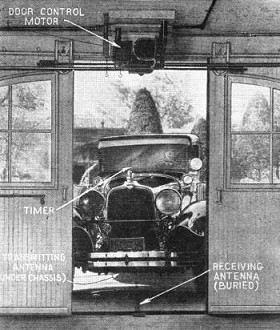
Fig. A - A view from the inside of a garage showing
the location of the equipment.
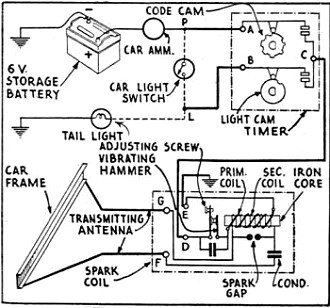
Fig. 1 - A diagram of the transmitter used in the radio-controlled
door opener. Note that the car frame is used as the radiating system.
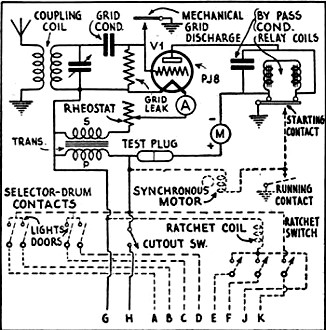
Fig. 2 - Diagram of the receiver pictured in Fig. C.
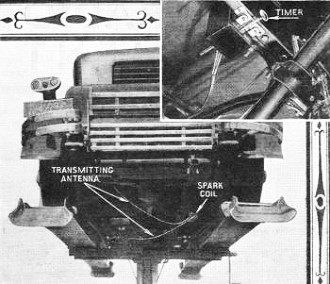
Fig. B - The illustration at the upper right shows
the location of the timer while the larger photograph shows the location of
the spark-coil transmitter.
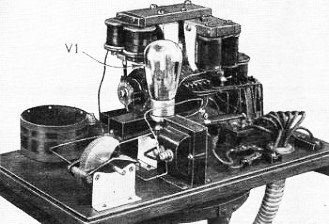
Fig. C - A close-up of the receiver, usually mounted
on one of the walls of the garage.
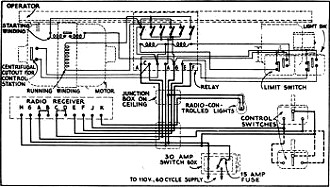
Fig. 3 - Complete schematic circuit of the motor and
light-control circuits used in this system. The output of the receiver works
"the works."
R. D. Washburne
A commercial system for the remote control of garage doors. etc. A 100-meter
signal radiated by a transmitter located in, for example, an automobile is picked
up by a receiver and, in turn, actuates a door-opening or closing motor. A "code"
prevents tampering or accidental operation of the system.
"Presto!" is the "open Sesame" which controls the door of the really modern
garage. Press a button and, lo, the portals of your garage swing wide before
you, lock open while you majestically continue your ride; and then, at a second
press of the button, close and lock, whether you are leaving your garage or
returning to it. We will now (with due apologies to the ads) disclose the "trick."
A radio transmitter mounted in the automobile transmits a short-wave signal
of "coded" or pre-determined dot-dash characteristics, when a knob on the instrument
board is pressed. This signal is radiated by a one-wire antenna underneath the
car chassis, and is picked up by a one-wire antenna buried in the driveway.
The latter antenna is connected to a receiving set which "de-codes" the signal,
and then operates motors which control the opening, closing and locking of the
garage doors. Literally, the system is a "radio key."
A display at A Century of Progress illustrates this procedure. An idea of
the relative parts arrangement may be obtained by reference to the cover illustration
and Fig. A. A schematic circuit of the radio transmitter located in the
car is shown in Fig, 1. The receiver connections are shown in Fig. 2. The
door motor, which operates only when a particular set of signals is received,
connects to the receiver as shown in Fig. 3.
As shown in Fig. 1, a simple spark coil arrangement is sufficient for
the transmitter requirements of this installation. The transmission is rather
broad, on a wavelength of 100 meters. However, the field of radiation is confined
by the body of the car almost entirely to an area immediately underneath the
car, thus preventing interference on nearby receiving sets, Such slight interference
as may be introduced on extremely sensitive receivers, or those operating on
short waves, is of little consequence as the units operate ordinarily at considerable
intervals, and then only for about three seconds. The spark coil unit is contained
in a water-tight case and is bolted to the underside of the car chassis.
The transmitter timer, shown only in schematic form in Fig. 1, clamps
to the instrument board, and consists of a rack-and-pinion arrangement incorporating
a balance wheel, escapement wheel, hairspring, pallet lever, and a contact plate
and contact springs. The rack-and-pinion mechanism is controlled by a plunger.
The timer action is set at the factory with a combination which is different
for every installation. It is put into operation by a thrust on the plunger
which extends from the lower edge of the instrument board of the automobile.
Since a similarly-coded action is installed at the receiver, it is not possible
for static, or the radiations of a transmitter not equipped with the same code,
to actuate the door motor.
In reference to the diagram of the transmitter, the car wiring is shown in
dotted lines; external wiring is shown in heavy lines; and, internal wiring
is shown in light lines.
Radio-Controlled Garage Lights!
It is of considerable interest to note that the lights inside the garage
may be automatically turned on and off by radio. This is accomplished by an
added impulse in the code, which is transmitted only when the lights of the
car are turned on (thus completing a section of the car lighting circuit which
is wired to the radio control system).
The antenna which connects to the transmitter is strung diagonally underneath
the chassis. The receiving antenna, about 150 ft. long, is buried a few inches
deep in the driveway.
The receiver must be in continuous operation; consequently, the amplifier
tube, V1, shown in Fig. 2, is specially designed for continuous operation
over a minimum period of 2 1/2 years. For testing; this tube a D.C. milliammeter
of 0 to 15 ma. range is connected into circuit at M; for the same purpose an
A.C. ammeter of 0 to 2 A. range is connected at A. (This tube is of the type
developed for use in automatic train control equipment.) The output of V1 actuates
the de-coding mechanism, a set of relays and electromagnets operating a pawl-and-ratchet
system that rotates worm gears and a number of discs which close contacts. One
receiver can control, at will, either side of a 2-car garage. The stock receiver
and door operating units are designed to operate on 110 V., 60 cycles, A.C.
The components are protected by a metal shield-can; the assembly is mounted
inside the garage, fairly close to the door-operating motor.
A split-phase motor is used in the door-opening and closing system, the circuit
of which is shown in Fig. 3. In this figure, heavy lines indicate external
wiring. Any number of the manual control switches may be placed in con-venient
locations. Although our major interest lies in the radio components, the action
of the door control also is described.
Power is transferred from the motor unit, when starting contact is made,
to a latch magnet, by means of an arma-ture and spring-operated lever, releas-ing
a brake and closing the main motor switch at the lever end. As soon as the electric
motor reaches normal speed, in about one-half second, a centrifugal clutch engages
and passes the motion on to a planetary differential which. forms the main part
of the release mechanism. A pawl holds the ring gear fixed until the load exceeds
a set amount, and then trips. This per-mits the ring gear to run free and the
motor, which continues to run, is dis-connected from the driving pinion. The
driving pinion causes the door to open or close.
At the end of the door travel a cam shaft is automatically operated. It opens
the main motor switch and ap-plies a brake which stops the door. At the same
time the release mechanism is locked by a locking lever so that any attempt
to force the door will not trip the release mechanism. Also, the motor control
switch is shifted and the motor prepared to operate in the reverse di-rection
on the next signal; an additional switch for controlling the lights also is
shifted.
Radio control of the garage door permits the motorist to enter or leave his
car under shelter, a boon when it's "raining pitchforks," or in blizzard weather.
Incidentally, the same princi-ples may be applied to the operation of doors
within the home.
The radio light control feature of this installation has several points of
particular interest to the car owner.
As the car is driven up the driveway and the door-control plunger is operated,
the garage, driveway and yard are suddenly flooded with light, provided the
headlights of the car are turned on-as for night driving. A conveniently located
switch inside the house makes it easy to extinguish the garage and yard lights
in case it is de-sired to leave them turned on until the owner is inside his
home. This provi-sion minimizes the possibility of a ma-rauder lurking about,
since all local areas become flooded with light. Thus, for a few hundred dollars
the provi-dent person may possess a useful "magic wand."
Installations throughout the country have proved that this "unseen servant"
is an absolutely practical mechanism -another effective member of the radio
"robot" family. Whether the Service Man will be able to obtain this equip-ment
for private installation cannot be definitely stated at the present time. To
date, all "radio door" installations have been made only by a corps of techni-cians
trained by the manufacturer of the system.
Posted January 26, 2021
(updated from original post on 11/23/2014)
|


































